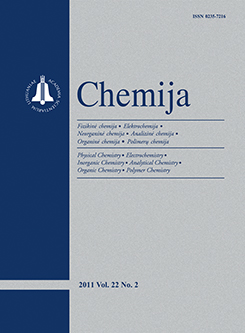Chemija / Chemistry
 ISSN 0235-7216 ISSN 2424-4538 (online) |
2015 m. Nr. 4 Annealing effect on the structural and optical properties of black chromium electrodeposited from the Cr(III) bath
Black chromium coatings were deposited on a steel substrate from the Cr(III) electrolyte containing ZnO as a second main component. The changes in the physical and optical properties of the sample owing to thermal degradation were examined by X-ray diffraction (XRD), transmission electron microscopy (TEM), X-ray photoelectron spectroscopy (XPS), scanning electron microscopy (SEM) and spectrophotometry. The coatings were annealed at a temperature of 600 °C in a nitrogen atmosphere for 2 hours to study the influence of annealing temperature on the structural, chemical and optical properties of black chromium. It has been found that the chromium solid solution in zinc of a hexagonal structure (hcp) along with that of zinc in chromium (bcc) may be formed during the electrodeposition of black chromium. The annealed black chromium was found to have dendrite-like ZnO and ZnCr2O4 particles of a crystalline structure and a small amount of Fe2O3, which is the result of oxidation of the steel substrate during the annealing process. Besides, a small quantity of iron atoms from the substrate was found to be incorporated into the ZnCr2O4 lattice. Therefore, the XRD patterns showed the presence of FeCrZnO4. The analysis of the near-surface layers suggests that as-deposited black chromium is rich in hydroxides of both chromium and zinc and contains inclusions of metallic chromium, whereas after annealing of the sample the oxides become dominant in the absence of metallic Cr. The optical properties were characterized by the reflectance spectral measurements of the black coatings. The optical measurements have shown that the samples annealed at 600 °C exhibited a lower absorptivity compared to that for as-deposited black chromium, which depicted good absorptance properties for the absorption of solar energy. An increase in reflectance after annealing of the samples was found to be arising from the diffusion of the substrate material (Fe) into black chromium and the changes in the chemical composition and structure of the deposit. These findings confirm some of earlier observations and provide new information relating to the ability of black Cr–Zn coatings to collect solar energy.
Keywords: solar selective black chromium, morphology, phase structure, optical properties |
Issues:
2017 - Vol.28 No. 1, No. 2, No. 3, No. 4 2016 - Vol.27 No. 1, No. 2, No. 3, No. 4 2015 - Vol.26 No. 1, No. 2, No. 3, No. 4 2014 - Vol.25 No. 1, No. 2, No. 3, No. 4 2013 - Vol.24 No. 1, No. 2, No. 3, No. 4 2012 - Vol.23 No. 1, No. 2, No. 3, No. 4 2011 - Vol.22 No. 1, No. 2, No. 3, No. 4 2010 - Vol.21 No. 1, No. 2-4 2009 - Vol.20 No. 1, No. 2, No. 3, No. 4 2008 - Vol.19 No. 1, No. 2, No. 3-4 2007 - Vol.18 No. 1, No. 2, No. 3, No. 4 2006 - Vol.17 No. 1, No. 2-3, No. 4 2005 - Vol.16 No. 1, No. 2, No. 3-4 2004 - Vol.15 No. 1, No. 2, No. 3, No. 4 2003 - Vol.14 No. 1, No. 2, No. 3, No. 4 2002 - Vol.13 No. 1, No. 2, No. 3, No. 4 2001 - Vol.12 No. 1, No. 2, No. 3, No. 4 |